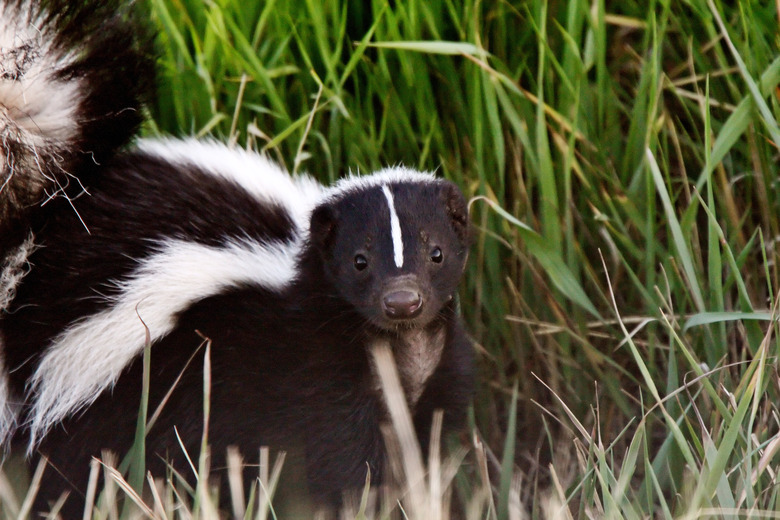Physical & Behavioral Adaptation Of Skunks
Skunks are small mammals with distinctive physical and behavioral adaptations. Physical adaptations refer to the adjustments to organism's physical features as a means of survival. Behavioral adaptations refer to the adaptations in the way an organism behaves, also as a means of survival.
Stripes
Stripes
The stripes on a skunk are a physical adaptation. Skunks usually have a black coat with two white stripes down the back. They also have one white stripe down their foreheads. These vivid stripes stand out from their black fur and serve as a warning to would-be predators to keep their distance. Predators of skunks include human beings, foxes, coyotes and bobcats.
Musk Glands
Musk Glands
All skunks have highly evolved musk glands. This is one of their most famous physical adaptations. These glands are located on either side of a skunk's anus and produce a fluid with a highly offensive smell. This fluid is a defensive weapon which the skunk uses against its potential predators. Skunks use this fluid sparingly and only spray victims when they feel threatened. Usually, when a skunk is alarmed, it will arch its back in an attempt to look larger. It will bare its teeth and snarl at an intruder. If this does not work, it will spray the smelly fluid as a last resort. The fluid may cause temporary blindness and a burning sensation. It is also very difficult to remove the smell from the skin, fur, or, in the case of human contact, clothing.
Nocturnal
Nocturnal
Skunks are mostly nocturnal animals, which means they are most active at night. This is a behavioral adaptation that has several benefits. It helps the skunks conserve their energy during the day when it might be too warm. It protects them from predators that might otherwise prey on them in the daytime. They also use the opportunity to hunt for food like fruit, small animals and insects, without having to worry as much about becoming food for other creatures themselves.
Dens
Dens
Skunks are burrowing animals and may dig their dens underground in various places. It is not uncommon to find skunks under porches, woodpiles, rocks or even in abandoned buildings. During the fall, skunks usually eat voraciously so as to increase their body mass. During the winter, communities of skunks and their offspring move together into dens to stay warm. Skunks do not hibernate, but they will remain inactive while it is cold. During this time, they will live off the body fat they have stored over the fall.
Cite This Article
MLA
E, Jenny. "Physical & Behavioral Adaptation Of Skunks" sciencing.com, https://www.sciencing.com/physical-behavioral-adaptation-skunks-8573139/. 22 November 2019.
APA
E, Jenny. (2019, November 22). Physical & Behavioral Adaptation Of Skunks. sciencing.com. Retrieved from https://www.sciencing.com/physical-behavioral-adaptation-skunks-8573139/
Chicago
E, Jenny. Physical & Behavioral Adaptation Of Skunks last modified March 24, 2022. https://www.sciencing.com/physical-behavioral-adaptation-skunks-8573139/
